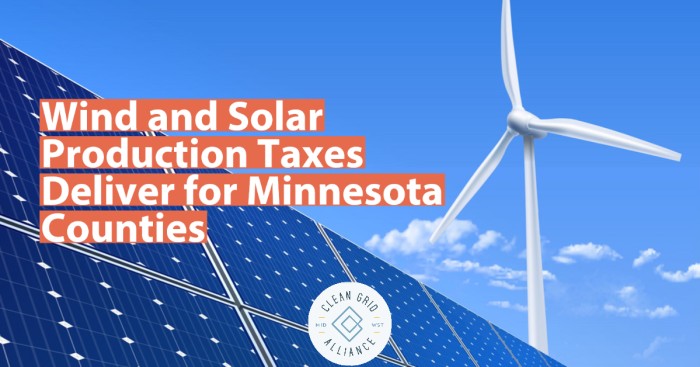Wind and Solar Production Taxes Deliver for Minnesota Counties
 | Holly Fritz, Communications/Policy Associate |

 | Holly Fritz, Communications/Policy Associate |
Minnesota is a national leader in the transition from fossil fuels to clean energy. Renewables provide 25 percent of Minnesota’s in-state electricity, about 10 percent above the national average. Minnesota is also home to the Midwest’s largest Solar + Storage project, located in Ramsey and Athens Township. In addition to providing clean energy and reducing carbon emissions, renewables, like wind and solar, have provided economic stability to Minnesota’s counties throughout the years.
Production taxes are one way communities can benefit from wind and solar projects. In Minnesota, 53 of the state’s counties benefit from the revenue generated by wind and solar. Every year, the Minnesota Department of Revenue releases a report detailing production taxes paid by wind and solar projects to the counties that host them. This year, the report shows that Minnesota’s counties have received more than $14 million in wind and solar production tax revenue. This revenue has been very helpful for counties in need of funds to improve infrastructure, schools and public buildings and help keep property taxes down for all residents.
Wind energy benefits 31 percent of Minnesota’s counties. As the number one producer of wind energy in the state, Mower County received over $2.1 million in production taxes this year. The county has been benefitting from the Wind Energy Production Tax since 2004. In 2019, the county used this revenue for improving roads, as well as building renovations and updating the local fairgrounds. The remainder was put into a general fund that was used to reduce the tax levy. This revenue lowered Mower County’s tax levy by 2.85 percent in 2019.
Solar is still in its infancy in the state, but is providing benefits nonetheless. Over 1,000 MW of solar in the state are powering nearly 200,000 homes. Solar production tax revenue reached over $1.5 million in 2019. Chisago County received $300,000 in revenue from solar alone, making it the number one county in the state for solar production tax revenue.
There’s no doubt renewable energy has created great economic opportunities in Minnesota’s rural communities. It takes less than one acre to host a wind turbine, leaving plenty of room for farmers to use their land as they see fit. Landowners may lease their land for wind projects for the entirety of a turbine’s lifespan, providing a new cash crop through the annual lease payments. In 2019, Minnesota landowners that host wind projects received $26 million in annual lease payments. This not only helps farmers provide a stable income for their families, but it also gives them the freedom to use those dollars as they choose. Many landowners invest in their homes, outbuildings, drainage and irrigation systems, new equipment, or even college tuition. In 2019, $706 million in lease payments was paid to landowners all across the U.S.
Subscribe to our newsletter for the latest on energy & our work
Wind and solar are more than just clean, reliable energy sources. They’re economic drivers for smaller communities, many of which must stretch their budgets. Thanks to wind and solar, farmers can keep their land in the family and counties can afford to provide citizens with the services and resources they need. More than $912 million in state and local taxes was paid for by wind energy, and an additional 14 million homes are projected to be powered by wind in the next year. Over 700 MW of Minnesota solar is expected to hit the grid in the next five years.
Renewable energy is providing important benefits for Minnesotans – and that’s just smart.